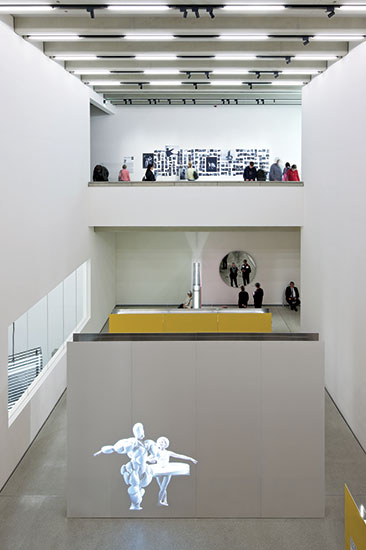One hundred years after the Bauhaus was founded, its products have become so ubiquitous that they’ve faded into the background– or else descended into kitsch. Nothing says generic corporate lobby like a Mies van der Rohe Barcelona chair, while Josef Albers’s colored nesting tables have been replicated to oblivion. In this centenary year of design-themed German travel articles and glossy features on overpriced limited-edition products, it is easy to suffer from Bauhaus fatigue. But persevere. Because the new Bauhaus Museum in Weimar has the power to surprise even the most hardened design geek.
“We wanted to tell the story of the early years of the Bauhaus, which isn’t so well known,” says Wolfgang Holler, director of the Klassik Stiftung Weimar, the city’s foundation for cultural heritage, which initiated the $30 million museum. He is standing in the first-floor exhibition, where the objects around him range from Expressionist sculptures to folksy ceramic pots, a far cry from what you might think of as the stripped-down “Bauhaus style.” Instead, what emerges is a picture of a wildly heterogeneous place, where breathing exercises taught by pseudo-Zoroastrian vegan painters were conducted side by side with welding classes and cosmic-puppetry workshops.

The riotous range of work on show stands in marked contrast to the neutral, if not bleak, container in which it is housed. The result of an open international competition in 2012, the design is the first built work of Heike Hanada, a German architect who studied and taught at the current Bauhaus University in Weimar. Her building stands as a blank gray concrete block on the edge of a new public space, relieved only by thin, indented horizontal strata, which glow at night like the lines of a musical score. Its austere, uncompromising form has provoked a mixed reception. Some locals call it the bunker. Others have compared it to the imposing Nazi-era stone tower across the street, designed to the orders of Hitler himself. Either way, it exudes the cold, monolithic presence of a memorial structure—which is somehow fitting. Weimar’s right-wing politicians did their best to destroy the Bauhaus in its early days, and the city remains a hotbed of the conservative forces that finally drove the school out to Dessau in 1925.
“We had to make a tough statement to stand up to the highly political context,” says Hanada. The museum is located right next to the 1930s Gauforum, built by the National Socialists to administer their forced-labor program. With the country’s far right once again on the rise, the building’s central square (formerly named Adolf Hitler Platz) remains fenced off in order to prevent neo-Nazi gatherings.
Inside the museum, the large, windowless gallery spaces are kept simple and raw, with gray terrazzo floors, ribbed concrete ceilings, and white-painted concrete walls, a minimal world populated by steel handrails, felt-topped benches and naked light bulbs. “We tried to be as poor as possible with the materials,” says Hanada. The approach has paid off, allowing the work on show to stand out. There is plenty of room for the exhibitions to breathe, with sectional changes where the galleries leap from single to double and triple height, and places where windows are punched through so you can see to the levels above, while narrow staircases create a dramatic sense of compression and expansion as you move between the floors. As you leave, picture windows frame poignant views out to a memorial tower in the distance, marking the site of the Buchenwald concentration camp, whose gates were designed by prisoner and former Bauhaus student Franz Ehrlich.
The Weimar museum is the first of a trio of new buildings planned for the Bauhaus centenary, and the only one to be completed on time. Dessau, where Walter Gropius’s industrial studio complex still stands, is awaiting the September opening of a big glass hangar by the young Barcelona practice Addenda Architects (also the result of an open competition), planned to house a floating black-box gallery above an open ground floor. Berlin, where the Bauhaus fled for one final year in 1932, is to receive an extension to its Gropius-designed archive building, in the form of a glass tower by local architect Volker Staab, delayed until 2021.
Weimar is not only the first but, perhaps, the most important of the three, since it explains how the school was not a blip out of the blue but an evolution of what had been brewing in the region since the late 19th century. A fascinating complementary show at the city’s revamped Neues Museum nearby helps to illuminate how the work of figures like Henry van de Velde, who established Weimar’s School of Arts and Crafts in 1905, laid the foundations for what Gropius would develop. Together, the two museums reveal the Bauhaus period to be a richer and more complex phenomenon than you might ever have imagined.









Post a comment to this article
Report Abusive Comment